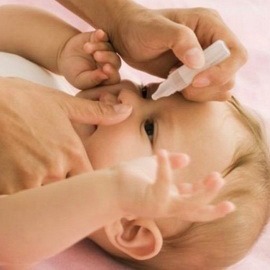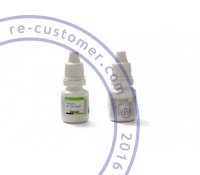 Every mother knows that eye drops for children are used quite often. The most common cause of the need for kid’s eye drops is an infection that has settled on the mucous eye. It can be a bacterial or viral infection, or simply bacteria that got into the eyes because of dirty hands. In any case, the illnesses of the children's eyes are best treated locally, when the medicament is applied directly to the mucous eyes. But not every mother who received a recommendation from a pediatrician to use eye drops for her baby knows how to do it correctly. After all, the eye, even in an adult person, is a very sensitive organ, and the slightest misstep or negligence can lead to disastrous results. Therefore, in this article, we will talk about how to put eye drops in kid’s eyes properly and what they are generally needed for.
Every mother knows that eye drops for children are used quite often. The most common cause of the need for kid’s eye drops is an infection that has settled on the mucous eye. It can be a bacterial or viral infection, or simply bacteria that got into the eyes because of dirty hands. In any case, the illnesses of the children's eyes are best treated locally, when the medicament is applied directly to the mucous eyes. But not every mother who received a recommendation from a pediatrician to use eye drops for her baby knows how to do it correctly. After all, the eye, even in an adult person, is a very sensitive organ, and the slightest misstep or negligence can lead to disastrous results. Therefore, in this article, we will talk about how to put eye drops in kid’s eyes properly and what they are generally needed for.
Along with the question of how to use eye drops, the parents want to know why they are needed. After all, not all kids behave well during this procedure (they are capricious, crying and try to squeeze their eyes) and parents are looking for an alternative way to get rid of a particular eye ailment. But if you analyze the assortment of a traditional drugstore or a Denmark online pharmacy you’ll see there are no many alternatives. The situations when you need to use eye drops for kids:
1. Dry eye syndrome. This trouble is found in kids who spend a lot of time reading books or working with a computer. A characteristic sign of dry eye is soreness, photosensitivity and a feeling of acute pain in the eyes. Excessive eye strain leads to the fact that tears (tear fluid) begin to be produced slowly and not in the amount that is necessary to moisten the mucous eye and cornea. Therefore, the ophthalmologist may recommend eye drops for sore eyes in children that are similar to natural tears.
2. Infectious conjunctivitis. Since the toddlers do not yet realize the importance of personal hygiene, they often rub their eyes and the whole face with dirty hands and bring in different bacteria. Therefore, in kids under 4 years old and sometimes older, the risk of developing conjunctivitis of bacterial origin is very high. In such cases, usually are prescribed eye drops for conjunctivitis in children containing antibiotics and a number of active ingredients aimed at removing the inflammatory process, suppressing the growth of the pathogenic flora, and having antiallergic effect.
3. Use of atropine. This remedy is used before visiting an ophthalmologist, if the child is suspected of being short-sighted. Atropine should be used for 3-4 days, so that the pupil increased in size expanded. After that, the ophthalmologist will determine the refractoriness of vision, having examined the eye of the baby through a special apparatus.
How to give eye drops to a child? Before you use eye drops, you need to carefully prepare for this.
- Wash your hands with soap
- Wipe the pipette with antiseptic or boiling water if there is no dispenser in the vial
- Place near you a cotton wool or a clean cloth from natural fabric
- Pay attention to the temperature of the medicine, it must correspond to the temperature of the room
Since young children cannot comprehend the need for this procedure, be aware of the fact that the kid will most likely try to resist and be very capricious. Therefore, it is better to carry out this manipulation with an assistant.
Put the baby on any surface that is convenient for you. It is better, if the crumb at this moment will be wrapped in a baby blanket, so that the baby does not wave the hands and let you finish the procedure quickly. Now you need the help of a second person, who must fix the head of the little one, holding his or her forehead with the palm of his hand. Do not use force; everything should be as accurate as possible. Putting the baby in the right position, you can start instilling the drops.
Next, with the cotton pads, soaked in the boiled water at room temperature, wipe the baby's eyes, removing purulent crusts from it. Wipe the eyes only from the outer edge, slowly swatting in the direction of the nose. For every eyelid, you must take a new cotton pad so that you do not infect a healthy eye.
Gently pull the lower eyelid down and, without touching the baby's eye, instill the prescribed remedy. Instill the drops of a safe eye drops for children near the bridge of the nose, so the fluid is distributed on the mucous of the eye. Let the baby blink, and then proceed to the second eye.
If the fluid has leaked out a little, wipe the excess with a cotton disc.
With older children, you can try to talk and explain what is happening. But it is not worthwhile to hope that your little one will understand, because even the most intelligent kid, once experienced treatment with eye drops, almost certainly will begin to resist. Therefore, in some cases, you will also need the help of a second person who will have to hold the child's hands. If the toddler resists and cries, try making this process a game. Toddler eye drop methods are similar to those described above. Remember that any violence, even for a good purpose, harms your child's psyche, so try to find a way to negotiate with the kid.
Children of school age usually carry out this procedure without problems. The process of putting eye drops is the same as in case with babies, only older kids can be in a sitting position.
The medicine almost did not enter the baby's eye what can the mother do? Since the kid resists in every way, turn the head in different directions, and closes the eyes, the medicine may not get into the destination. But if you manage to put a few droplets into the inner part of the eye, where there is a section of the lacrimal gland, the medicine will still fall into the eye, even if it is closed. After all, the kid will open the eye, and the fluid can penetrate the cornea. Of course, some of the fluid will flow out, but the necessary amount of it will stay on the eye.
Some mothers can hardly imagine how to administer eye drops in children, because we all love our babies very much and we do not want to give them pain. Therefore, the most important thing is to do everything as carefully and calmly as possible. And do not forget that everything should be sterile. Now, you know the tips for giving your kid eye drops.







